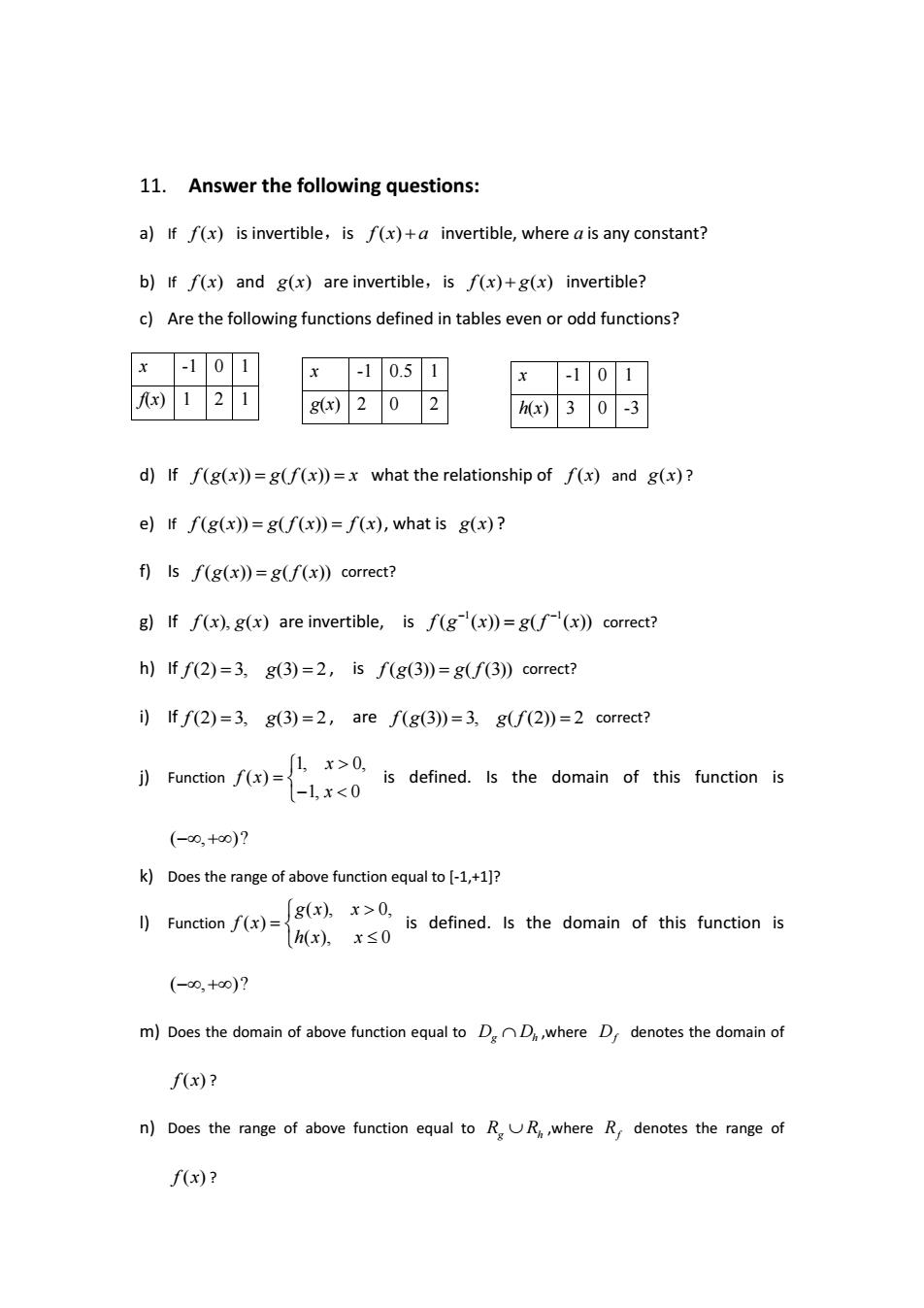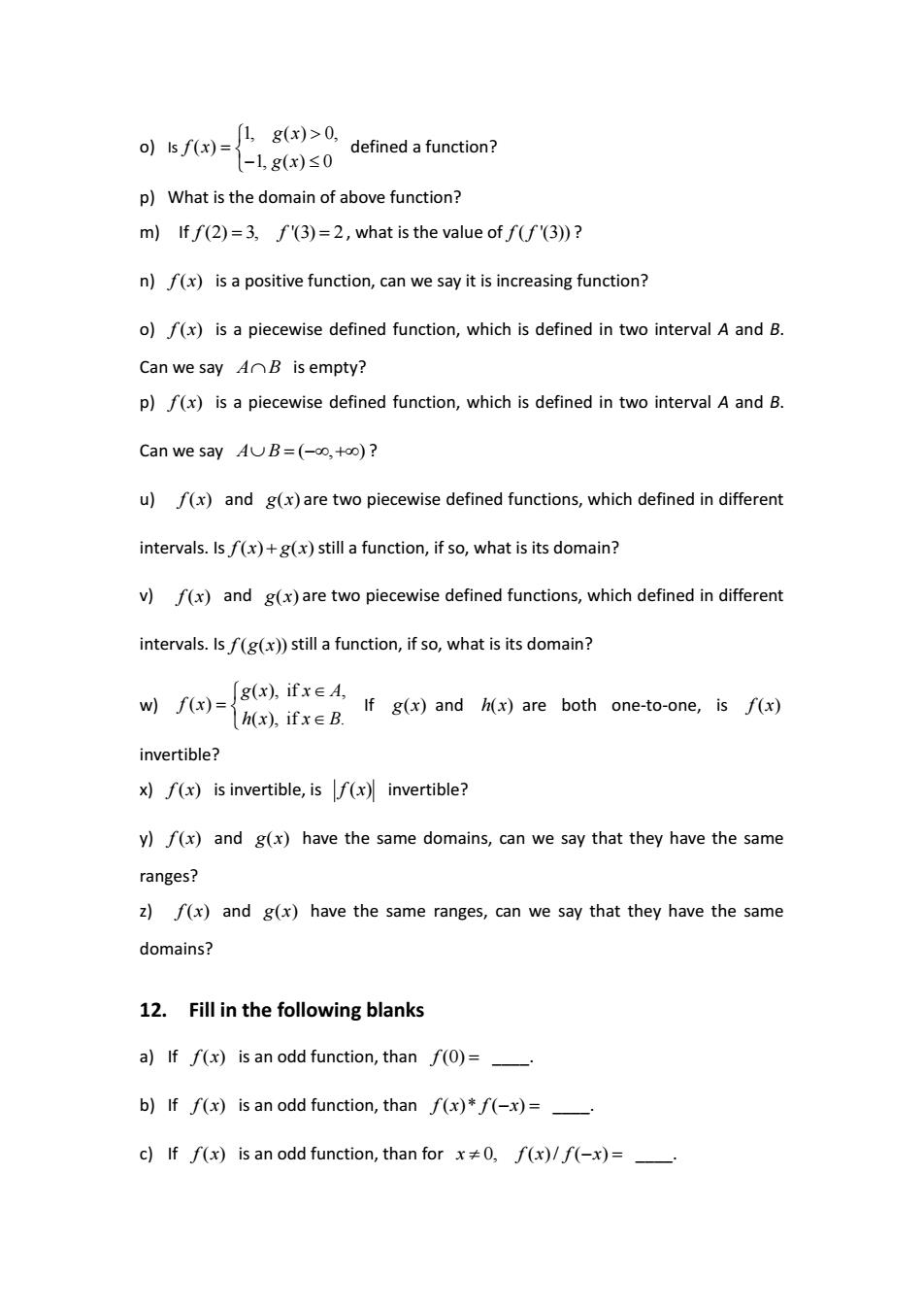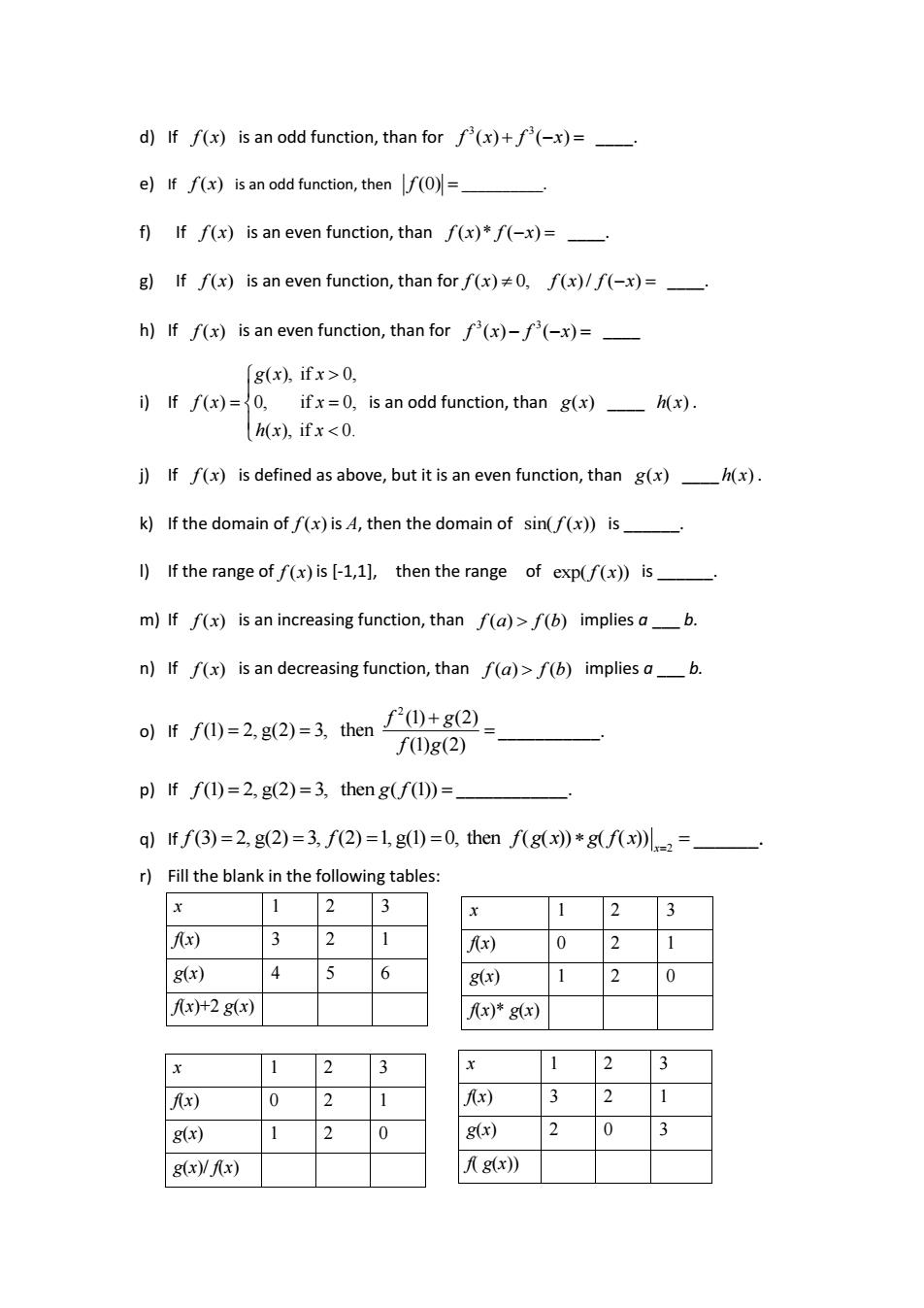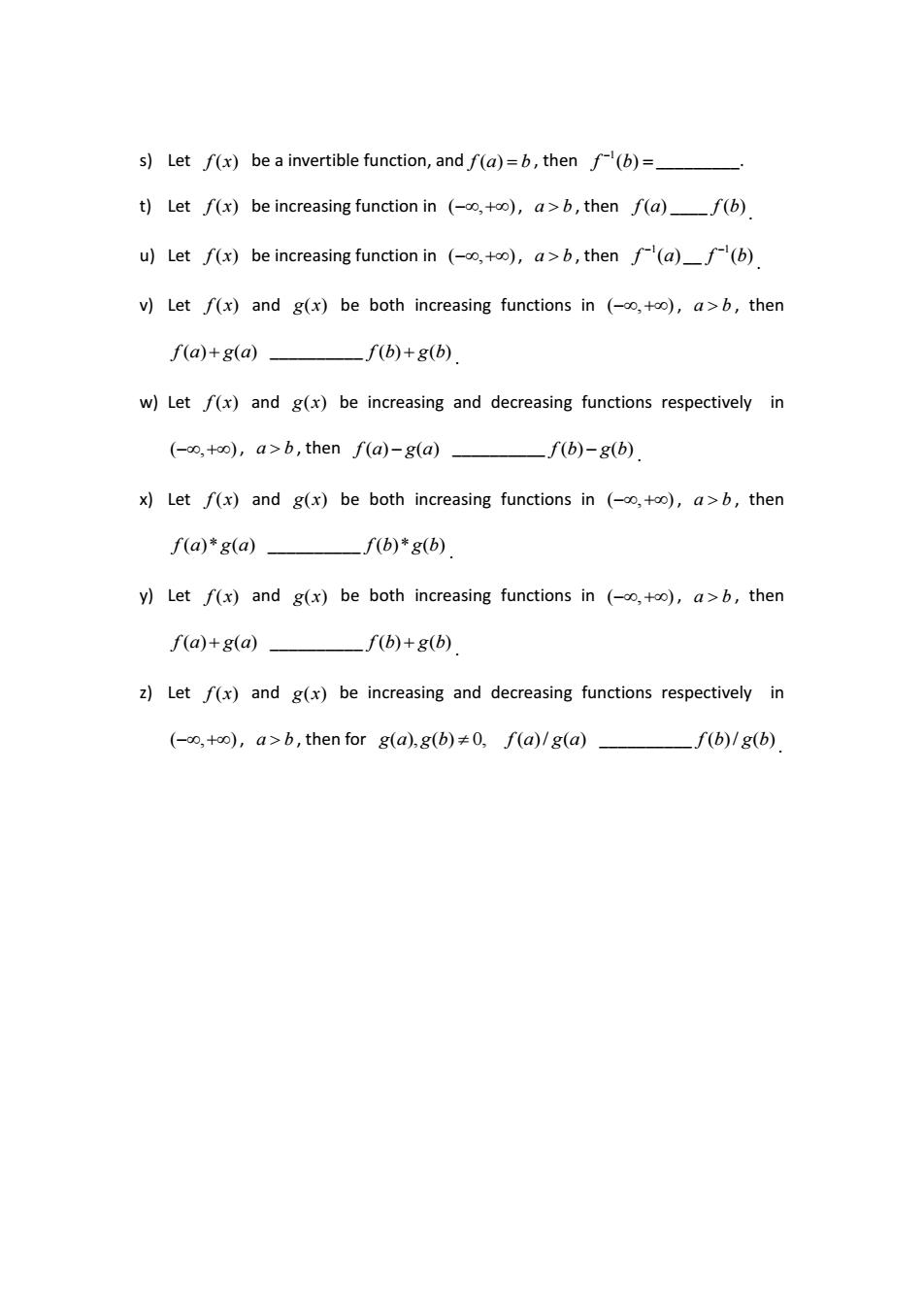
11.Answer the following questions: a)Iff(x)is invertible,is f(x)+a invertible,where ais any constant? b)If f(x)and g(x)are invertible,is f(x)+g(x)invertible? c)Are the following functions defined in tables even or odd functions? x-101 x-10.51 x-101 )121 gx)202 h)30-3 d)If f(g(x))=g(f(x))=x what the relationship of f(x)and g(x)? e)ffg(x》=gfx》=fx),what is g(x)? f)Is f(g(x))=g(f(x))correct? g)If f(x).g(x)are invertible,is f(g(x))=gf(x))correct? h)If f(2)=3.g(3)=2,is f(g(3))=g(f(3))correct? i)If f(2)=3,g(3)=2,are f(g(3))=3,g(f(2))=2 correct? )Function is defined.is the domain of this function is -1,x<0 (-,+0)2 k)Does the range of above function equal to [-1,+1]? (is defined.Is the domain of this function is 1)Function f(x)h(x). (-0,+o)2 m)Does the domain of above function equal to DDwhere D,denotes the domain of f(x)? n)Does the range of above function equal toR,where R denotes the range of f(x)?
11. Answer the following questions: a) If f x( ) is invertible,is f x a ( ) invertible, where a is any constant? b) If f x( ) and g x( ) are invertible,is f x g x ( ) ( ) invertible? c) Are the following functions defined in tables even or odd functions? d) If f g x g f x x ( ( )) ( ( )) what the relationship of f x( ) and g x( ) ? e) If f g x g f x f x ( ( )) ( ( )) ( ) , what is g x( ) ? f) Is f g x g f x ( ( )) ( ( )) correct? g) If f x g x ( ), ( ) are invertible, is 1 1 f g x g f x ( ( )) ( ( )) correct? h) If f g (2) 3, (3) 2 , is f g g f ( (3)) ( (3)) correct? i) If f g (2) 3, (3) 2 , are f g g f ( (3)) 3, ( (2)) 2 correct? j) Function 1, 0, ( ) 1, 0 x f x x is defined. Is the domain of this function is ( , )? k) Does the range of above function equal to [-1,+1]? l) Function ( ), 0, ( ) ( ), 0 g x x f x h x x is defined. Is the domain of this function is ( , )? m) Does the domain of above function equal to D D g h ,where Df denotes the domain of f x( ) ? n) Does the range of above function equal to R R g h ,where Rf denotes the range of f x( ) ? x -1 0 1 f(x) 1 2 1 x -1 0.5 1 g(x) 2 0 2 x -1 0 1 h(x) 3 0 -3

o)sf)=18)>0, defined a function? -l,g(x)≤0 p)What is the domain of above function? m)If f(2)=3.f(3)=2,what is the value of f(f'(3))? n)f(x)is a positive function,can we say it is increasing function? o)f(x)is a piecewise defined function,which is defined in two interval A and B Can we say AnB is empty? p)f(x)is a piecewise defined function,which is defined in two interval A and B. Can we say UB=(-0,+0)? u)f(x)and g(x)are two piecewise defined functions,which defined in different intervals.Isf(x)+g(x)still a function,if so,what is its domain? v)f(x)and g(x)are two piecewise defined functions,which defined in different intervals.Isf(g(x))still a function,if so,what is its domain? wo-女 If g(x)and h(x)are both one-to-one,is f(x) invertible?? x)f(x)is invertible,is f(x)invertible? y)f(x)and g(x)have the same domains,can we say that they have the same ranges? z)f(x)and g(x)have the same ranges,can we say that they have the same domains? 12.Fill in the following blanks a)If f(x)is an odd function,than f(0)=_ b)If f(x)is an odd function,than f(x)*f(-x)=_ c)If f(x)is an odd function,than for x0,f(x)/f(-x)=_
o) Is 1, ( ) 0, ( ) 1, ( ) 0 g x f x g x defined a function? p) What is the domain of above function? m) If f f (2) 3, '(3) 2 , what is the value of f f ( '(3)) ? n) f x( ) is a positive function, can we say it is increasing function? o) f x( ) is a piecewise defined function, which is defined in two interval A and B. Can we say A B is empty? p) f x( ) is a piecewise defined function, which is defined in two interval A and B. Can we say A B ( , ) ? u) f x( ) and g x( ) are two piecewise defined functions, which defined in different intervals. Is f x g x ( ) ( ) still a function, if so, what is its domain? v) f x( ) and g x( ) are two piecewise defined functions, which defined in different intervals. Is f g x ( ( )) still a function, if so, what is its domain? w) ( ), if , ( ) ( ), if . g x x A f x h x x B If g x( ) and h x( ) are both one-to-one, is f x( ) invertible? x) f x( ) is invertible, is f x( ) invertible? y) f x( ) and g x( ) have the same domains, can we say that they have the same ranges? z) f x( ) and g x( ) have the same ranges, can we say that they have the same domains? 12. Fill in the following blanks a) If f x( ) is an odd function, than f (0) ____. b) If f x( ) is an odd function, than f x f x ( )* ( ) ____. c) If f x( ) is an odd function, than for x f x f x 0, ( ) / ( ) ____

d)If f(x)is an odd function,than for(x)+f (-x)=_ e)If f(x)is an odd function,then f()=_ f)If f(x)is an even function,than f(x)f(-x)= g)If f(x)is an even function,than for f(x)0,f(x)/f(-x)=_ h)If f(x)is an even function,than for (x)-f(-x)= [g(x).ifx>0. i)If f(x)=0,ifx=0,is an odd function,than g(x)(x). (h(x),ifx<0. j)If f(x)is defined as above,but it is an even function,than g(x)(x). k)If the domain of f(x)is A,then the domain of sin(f(x))is_ 1)If the range of f(x)is [-1,1],then the range of exp(f(x))is_ m)If f(x)is an increasing function,than f(a)>(b)implies a_b. n)If f(x)is an decreasing function,than f(a)>f(b)implies a_b. o)ff0=2g2)=3,then0+82 f0)g(2) p)If f(1)=2.g(2)=3,then g(f(1))= q)Iff(3)=2,g(2)=3.f(2)=1g(1)=0,then f(g(x))*g(f(x))2=_ r)Fill the blank in the following tables: x 12 3 x 123 Ax) 3 2 1 fx) 021 g(x) 45 6 g(x) 1 20 Ax)+2 g(x) fx)"g(x) 1 2 3 123 0 2 1 Ax) 32 1 g(x) 1 2 0 g(x) 0 g(x)/fx) gx)》
d) If f x( ) is an odd function, than for 3 3 f x f x ( ) ( ) ____. e) If f x( ) is an odd function, then f (0) __________. f) If f x( ) is an even function, than f x f x ( )* ( ) ____. g) If f x( ) is an even function, than for f x f x f x ( ) 0, ( ) / ( ) ____. h) If f x( ) is an even function, than for 3 3 f x f x ( ) ( ) ____ i) If ( ), if 0, ( ) 0, if 0, ( ), if 0. g x x f x x h x x is an odd function, than g x( ) ____ h x( ) . j) If f x( ) is defined as above, but it is an even function, than g x( ) ____ h x( ) . k) If the domain of f x( ) is A, then the domain of sin( ( )) f x is ______. l) If the range of f x( ) is [-1,1], then the range of exp( ( )) f x is ______. m) If f x( ) is an increasing function, than f a f b ( ) ( ) implies a ___ b. n) If f x( ) is an decreasing function, than f a f b ( ) ( ) implies a ___ b. o) If 2 (1) (2) (1) 2, g(2) 3, then (1) (2) f g f f g ___________. p) If f g f (1) 2, g(2) 3, then ( (1)) ____________. q) If 2 (3) 2, g(2) 3, (2) 1, g(1) 0, then ( ( )) ( ( )) x f f f g x g f x ______. r) Fill the blank in the following tables: x 1 2 3 f(x) 3 2 1 g(x) 4 5 6 f(x)+2 g(x) x 1 2 3 f(x) 0 2 1 g(x) 1 2 0 f(x)* g(x) x 1 2 3 f(x) 0 2 1 g(x) 1 2 0 g(x)/ f(x) x 1 2 3 f(x) 3 2 1 g(x) 2 0 3 f( g(x))

s)Let f(x)be a invertible function,and f(a)=b,thenf(b)=_ t)Let f(x)be increasing function in (+)a>b,then f(a)_f(b) u)Let f(x)be increasing function in (+)a>b,then f(a)f(b) v)Let f(x)and g(x)be both increasing functions in (,+o),a>b,then f(a)+8(a)_ _f(b)+g(b) w)Let f(x)and g(x)be increasing and decreasing functions respectively in (-o,+0),a>b,then f(a)-g(a) fb)-gb) x)Let f(x)and g(x)be both increasing functions in (,+)a>b,then f(a)*g(a)—fb)*gb). y)Let f(x)and g(x)be both increasing functions in (,+o),a>b,then f(a)+g(a) f(b)+g(b). z)Let f(x)and g(x)be increasing and decreasing functions respectively in (-,+o),a>b,then for g(a,g(b)≠0,f(a/g(ad_ (b)1gb)
s) Let f x( ) be a invertible function, and f a b ( ) , then 1 f b( ) _________. t) Let f x( ) be increasing function in ( , ) , a b , then f a( ) ____ f b( ) . u) Let f x( ) be increasing function in ( , ) , a b , then 1 f a( ) __ 1 f b( ) . v) Let f x( ) and g x( ) be both increasing functions in ( , ) , a b , then f a g a ( ) ( ) __________ f b g b ( ) ( ) . w) Let f x( ) and g x( ) be increasing and decreasing functions respectively in ( , ) , a b , then f a g a ( ) ( ) __________ f b g b ( ) ( ) . x) Let f x( ) and g x( ) be both increasing functions in ( , ) , a b , then f a g a ( )* ( ) __________ f b g b ( )* ( ) . y) Let f x( ) and g x( ) be both increasing functions in ( , ) , a b , then f a g a ( ) ( ) __________ f b g b ( ) ( ) . z) Let f x( ) and g x( ) be increasing and decreasing functions respectively in ( , ) , a b , then for g a g b f a g a ( ), ( ) 0, ( )/ ( ) __________ f b g b ( )/ ( )

Chapter 2 Limit 1.Fill in the blanks a)If limf(x)=0,then lim f(x)= b)If lim /()=lim f(x)=2,then lim f(x)= 日f吗+=L,hen四U+-》= h f▣0+f0=100,em(0-fN-)= h e)If lim f(x)g(x)=2.lim g(x)=5,then lim f(x)= If lim /()g()=0.limg(x)=2,then lim f(x)= g)If lim f(x)/g(x)=0,limg(x)=1,then lim f(x)=_ hfm四.l,heng= i)If lim f(x)=2,then lim(-f(x))=_ 1 )fmf=3,theni9— k)If lim f(x)=c,then lim[af(x)(x)= )fmf=3,henm广西= m)If limx'f(x)=1,then limf(x)=_ n)If f(x)=-f(-x),limf(x)=L,then L= o)If lim f(x)=2.limf(x)=3.,then lim f(f(x))=_ p)If limf(x)=3.limg(x)=2.then lim(f(x)+2g(x))= a)If limf(x)=3.limg(x)=2.then lim (3f(x)-g(x))=_
Chapter 2 Limit 1. Fill in the blanks a) If 0 lim ( ) 0 x x f x , then 0 lim ( ) x x f x ______ b) If 0 0 lim ( ) lim ( ) 2 x x x x f x f x , then 0 lim ( ) x x f x ______ c) If 0 0 0 ( ) ( ) lim h f x h f x L h , then 0 0 0 lim ( ) ( ) h f x h f x ______ d) If 0 (1 ) (1) lim 1000 h f h f h , then 0 lim (1) (1 ) h f f h _____ e) If 0 0 lim ( ) ( ) 2, lim ( ) 5, x x x x f x g x g x then 0 lim ( ) x x f x ______ f) If 0 0 lim ( ) ( ) 0, lim ( ) 2, x x x x f x g x g x then 0 lim ( ) x x f x ______ g) If 0 0 lim ( ) / ( ) 0, lim ( ) 1, x x x x f x g x g x then 0 lim ( ) x x f x ______ h) If 0 ( ) lim 1, x f x x , then 0 lim ( ) x f x ______ i) If 0 lim ( ) 2 x x f x , then 0 lim ( ) x x f x ______ j) If 0 lim ( ) 3 x x f x , then 0 1 lim x x f x( ) ______ k) If 0 lim ( ) x x f x c , then 0 2 lim ( ) ( ) x x af x bf x ______ l) If 0 lim ( ) 3 x x f x , then 0 lim ( ) x x f x ______ m) If 2 0 lim ( ) 1, x x f x then 0 lim ( ) x f x ______ n) If 0 ( ) ( ), lim ( ) , x f x f x f x L then L= o) If 1 2 lim ( ) 2,lim ( ) 3, x x f x f x , then 1 lim ( ( )) x f f x ______ p) If 0 0 lim ( ) 3, lim ( ) 2, x x f x g x then 0 lim ( ) 2 ( ) x f x g x _____ q) If 0 0 lim ( ) 3, lim ( ) 2, x x f x g x then 2 0 lim 3 ( ) ( ) x f x g x ____